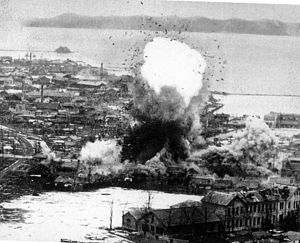Blockade of Wonsan
| Blockade of Wonsan | |||||||
|---|---|---|---|---|---|---|---|
| Part of the Korean War | |||||||
 An explosion destroys North Korean supplies during the blockade of Wonsan. |
|||||||
|
|||||||
| Belligerents | |||||||
|
|
|||||||
| Casualties and losses | |||||||
| 41 killed 158 wounded 1 patrol boat sunk 2 minesweepers sunk 1 battleship damaged 2 cruisers damaged 16 destroyers damaged 3 frigates damaged 5 minesweepers damaged 1 LSD damaged 3 LSMRs damaged |
unknown | ||||||
|
|||||||
The Blockade of Wonsan, or the Siege of Wonsan, from February 16, 1951 to July 27, 1953, during the Korean War, was the longest naval blockade in modern history, lasting 861 days. UN naval forces, primarily from the United States, successfully kept the strategically important city of Wonsan from being used by the North Korean Navy.
The blockade also served to divert communist troops from the front line. North Korean resistance used artillery to oppose the American fleet, although this was mostly ineffective, and the city was heavily damaged by UN naval aircraft and warships.
Wonsan was a strategic point during the war, located on North Korea's southeastern coast with a large harbor, an airfield, a petroleum refinery, 75,000 people, and as many as 80,000 troops, including several artillery batteries. After the Battle of Inchon, in which General Douglas MacArthur landed on the northwestern shores of the Korean peninsula, he ordered X Corps to make a landing at Wonsan where they would proceed west, link up with the Eighth Army and then advance towards Pyongyang, the capital of North Korea.
...
Wikipedia
